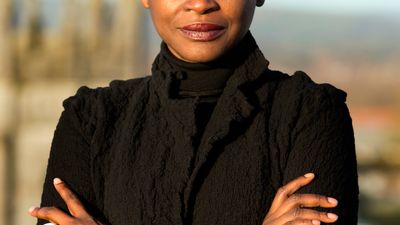Artists Explore Postcolonialism In Britain’s First Colony At Ireland’s Biennial
Koyo Kouoh has curated Ireland's 37th biennial of contemporary art, 'Still (the) Barbarians'
- Koyo Kouoh. Photo: Deirdre Power, courtesy of EVA International.
Entitled Still (the) Barbarians, Kouoh has drawn upon her own experiences of postcolonialism in Senegal and Cameroon in order to shape the theme of the biennial. Finding this discourse lacking in Ireland has motivated Kouoh to take forward a conversation about lasting colonial effects, in Limerick and beyond. “There are many works that deal with language, particularly in the context of Ireland losing Irish and trying to regain it. There are works dealing with trauma, with memory and with identity politics – key postcolonial concerns” says Kouoh.
- Godfried Donkor, Rebel Madonna Lace Collection (2016). Installation shot from EVA International – Ireland’s Biennial, 2016. Photo: Miriam O’Connor, courtesy of the artist and EVA.
Comparing the enduring manifestations of colonialism on modern day Ireland with Cameroon and Senegal, Kouoh explains “Colonialism’s physical domination, in terms of the shaping of architecture, civic spaces and the wider landscape, is accompanied by a psychological domination through the imposition of language, social structures, religion and prejudice.”
- Godfried Donkor, Ebony Accra Edition, 2014. Collage on paper, 70 cm x 100 cm. Courtesy of the artist.
For the biennial, Limerick-based artists Deirdre Power and Softday’s project looks at the legacy of the Easter Rising by holding a public competition and vote for a citizen’s anthem. The idea is the anthem “is representative of contemporary Ireland, and reflects on themes such as equal opportunities, liberalism, freedom, welfare, security and democracy,” says Kouoh. The winning anthem will be played by two Shannon Ices ice cream vans on the centenary.
- Abdoulaye Konate, The Butterflies Series (2016). Installation shot from EVA International – Ireland’s Biennial, 2016. Photo: Miriam O’Connor, courtesy the artist, Blain Southern and EVA.
The diverse range of works from around the world at EVA International and artistic interpretations of its theme highlight the postcolonial existence so many of us are living. Kudos to Koyo Kouoh who has made me as a half-Irish person in London, my Grandmother as a person from the north of Ireland, and probably most of Limerick, think a bit more about that.
Alice McCool is a freelance journalist, anti-corruption campaigner and masters student at the University of London’s School of Oriental and African Studies. You can tweet her at @McCoolingtons.
